On Aug. 16, 2020 the State of Michigan reported 93,662 total COVID-19 cases, an increase of 477 from the day prior. The number of new daily cases reported statewide on Aug. 16 is 11 more than what was reported on Aug. 15. New daily case numbers have been declining in recent days. In Chart 1 we show that the State total for the cumulative number of COVID cases on Aug. 16 was 92,572–a five-day rolling average. The five-day rolling average for the total number of COVID cases (Chart 1) reflects a smoother curve and adjusts for fluctuations in testing and/or the quality of reporting or failure to report.
Chart 2 shows that, based on the five-day rolling averages, the growth of new COVID cases in Southeastern Michigan continues to increase, particularly in the counties surrounding Detroit. On Aug. 16, Wayne County reported the highest number of cases in the region at 14,445. Oakland County reported 13,153 cases, which was just under Detroit’s 13,238 case total, and Macomb County reported 11,004.
Charts 3 and 3.1 (which is just a closer look at the data) show that Wayne, Oakland and Macomb counties all had the highest number of new daily cases on Aug. 16, according to the five-day rolling average. Wayne and Macomb counties each reported 100 new cases and Oakland County reported 99 new cases. This is consistent with what Dr. Joneigh Khaldun, Michigan’s Chief Medical Executive said yesterday; she stated that it is the counties surrounding Detroit (Macomb, Monroe, Oakland and Wayne counties) that are causing the region to see a spike in case numbers.
The daily data highlighted in these posts is from Michigan.gov/coronavirus, where data is updated daily at 3 p.m. Historical data were supplied from covidtracking.com, which republishes COVID data from the State. Additionally, the case totals do not reflect the number of people who have recovered, just those who have been infected. In early June the State changed how it reports its data on the website, making data more accurate in the long-term but more complicated to track as well. The State regularly updates older data and as we continue to publish regular updates on COVID the State’s changes to past data many not always be reflected in our posts. The data published in new posts is accurate for the day we received it on though.
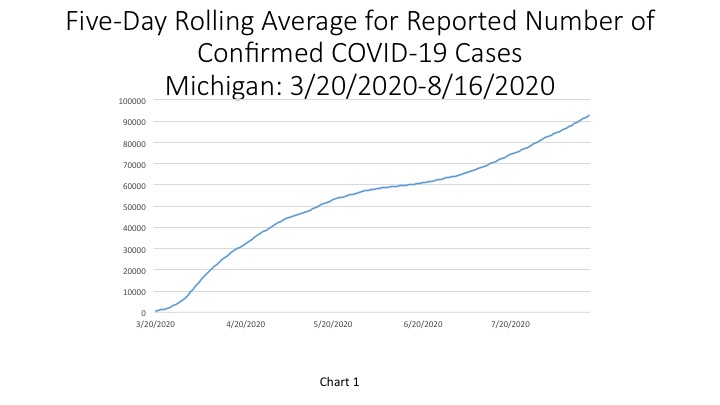
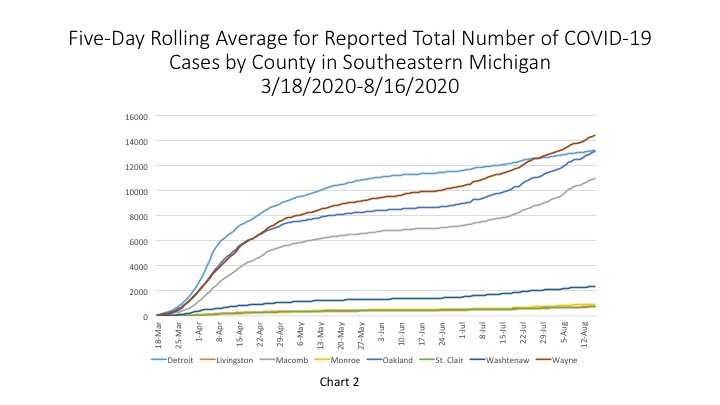
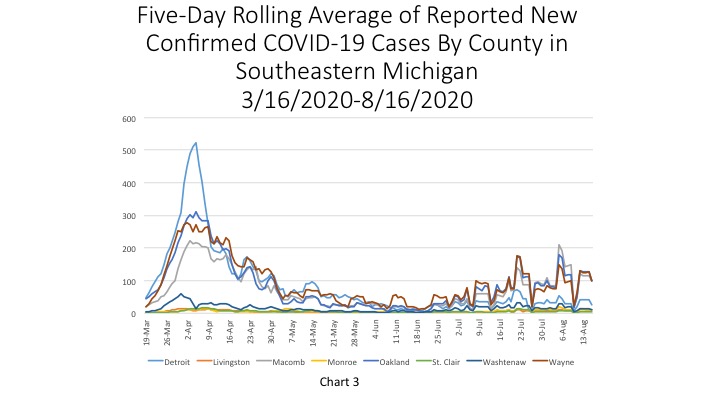
In Chart 4, the five-day rolling average, shows the number of deaths in the State of Michigan reached 6,321 on Aug. 16. The actual cumulative COVID-19 deaths on Aug. 18 was 6,340, an increase of 15 deaths from the prior day. However, of those 15 deaths, 7 were added to the daily total after death certificates were compared to the COVID database. Furthermore, of those 15 deaths 11 occurred in Southeastern Michigan.
Chart 6 (a 5-day rolling average) further hones in on how COVID related deaths have significantly flattened out, but that of those occurring the majority are in Southeastern Michigan. On Aug. 16, the City of Detroit reported 1,496 cumulative deaths (the most in the region). Wayne County had the second highest total at 1,211 deaths on Aug. 16.
Charts 7 and Chart 7.1 shows how, on Aug. 16 Oakland County reported the highest number of deaths at 2 and Detroit, Macomb, Oakland and Washtenaw counties each reported 1 death.
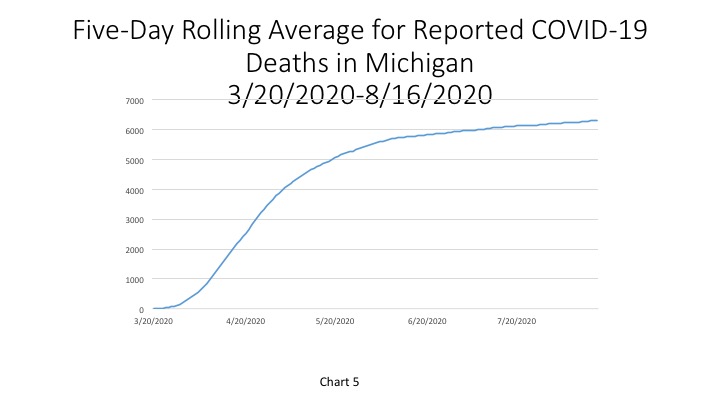
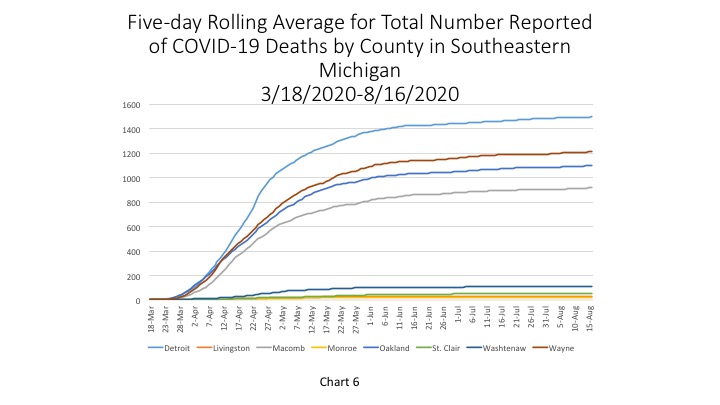
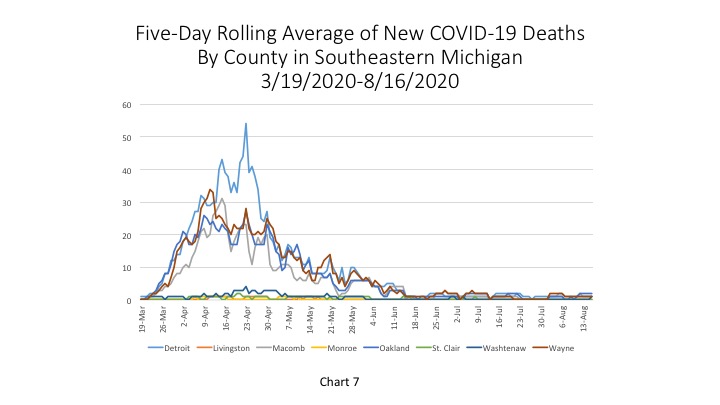
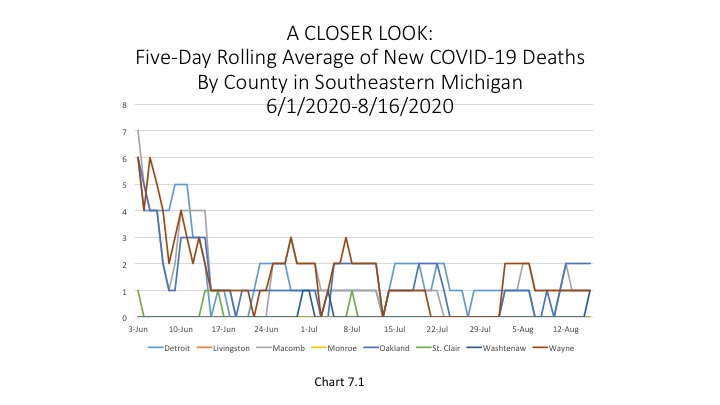
In addition to deaths remaining low and daily case numbers declining, Dr. Khaldun also said on Aug. 14 positive case rates are declining across the region. This too brings about some optimism. However, she also warned that trends must be watched to best determine our community responses. And, despite the recent positive trends we continue to see signs that we will be dealing with this pandemic long after the summer months. For example, just yesterday Michigan State University announced that it was pivoting to online classes. School districts across the State are also continuing to grapple with how they will proceed with the upcoming school year. So, while a few days of low new case and death numbers provide hope, the long-term approach to quelling this pandemic must be to carefully protect our children, the frail elderly and public health in general.